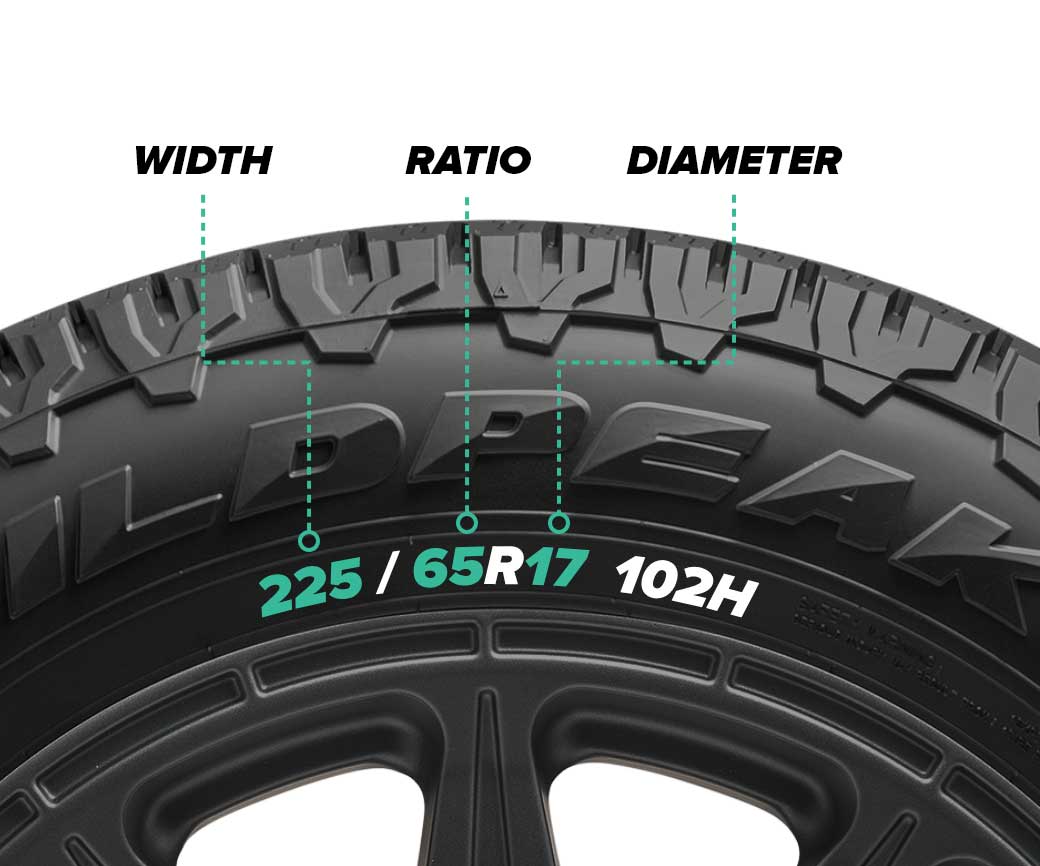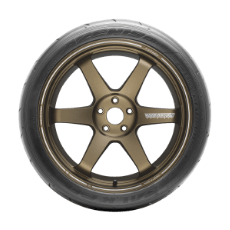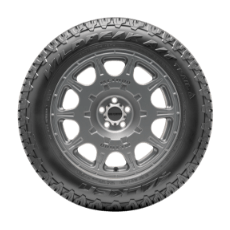Community - Ultra High Performance All-Season Tires Explained | Falken Tires
Ultra High Performance All-Season Tires Explained

Hi there. You’re probably here because you have questions. Questions like: what are Ultra High Performance All-Season (UHP A/S) tires? What’s the difference between touring and all-season tires? Are UHP tires good in the snow? What kind of tires do I need for our family road trip through Greenland in December? That’s a very specific inquiry; and if you happen to be one of the two Greenlanders who’ve visited our website this year, welcome back. We missed you. But we’ll answer these questions and more, after a word from one of our sponsors.
Falken recently launched an Ultra High Performance All-Season tire of our own: the Azenis FK460 A/S. Conveniently available right now, immediately upon you reading this blog post about UHP All-Season tires. Check it out here.

Now back to the show.
Overview of Tire Categories
To give ourselves a better understanding of what Ultra High Performance All-Season means, let’s begin by defining what All-Season and Ultra High Performance tires are.
All-Season
All-seasons are typically your do-it-all tires, kind of like a 3-in-1 shampoo + body wash + conditioner. It’s not the best shampoo you’ve ever used, nor is it world-class body wash, but the value and convenience are hard to beat. And that’s why so many Americans currently use 3-in-1 shampoo all-season tires.
It hasn’t always been this way, though. Prior to 1977, your only option was switching to winter tires every October / November, and back to summer tires once spring rolled around. Or you drove on the same set year-round and were ill-equipped for six months out of the year. In areas like Southern California, South Florida, or Hawaii, where temperatures rarely drop below 40 degrees Fahrenheit, you could get away with this. But if you lived basically anywhere else in North America, it was a different story.
Enter all-season tires. Offering a serviceable amount of winter capability along with acceptable dry handling and longer tread life, all-seasons can do it... all. And in a society that prioritizes convenience above all else (sup Bezos), it’s easy to see why all-season has become the de facto tire option.
Now, all-season is really more of a descriptor than it is a specific tire category. When it comes to passenger car tires (not for trucks), the “all-season” label can generally be applied to two different tire types: Touring and Ultra High Performance. Of course, there are subsegments within these segments. Otherwise this would all be way too easy to understand. In an attempt to simplify things, the chart below lays out the different categories that compose the passenger car tire market.
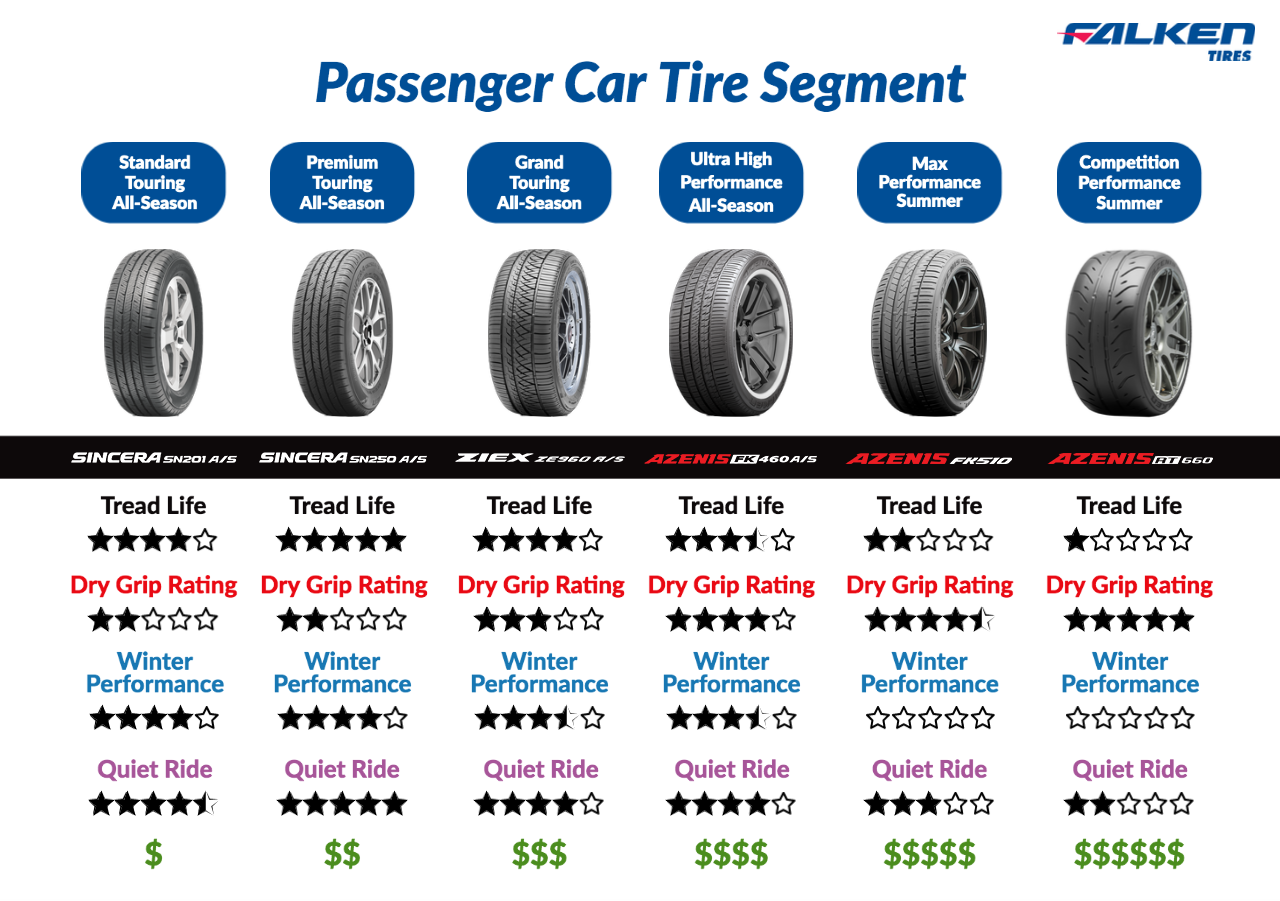
Touring (Standard, Premium, Grand)
As you can see, high-performance is not the #1 priority for Touring tires. Instead, these tires focus on delivering long tire life, a comfortable ride, and competency in all seasons (minus extreme winter conditions).
Standard Touring tires, like our Sincera SN201 A/S, are ideal for folks who just drive to get from Point A to Point B. Nothing fancy. They’ll last about 65,000 miles, keep you safe in the rain, and won’t drive you crazy with excessive noise.
Premium Touring is a step above Basic Touring. You’ll see a slight increase in price, with the point of differentiation varying by manufacturer. For Falken, the main differentiator is longer tread life - our Sincera SN250 A/S lasts up to 80,000 miles - though other brands may focus on delivering a quieter ride, enhancing wet traction, or reducing rolling resistance.
Then you get to Grand Touring, the top tier option within the Touring segment. In terms of performance, Grand Touring is generally the closest touring tires get to providing UHP-level grip and handling. For Falken, this would be our Ziex ZE960 A/S, which offers up to a 65,000-mile warranty and delivers wet weather traction that lasts throughout the life of the tire. For drivers who want to enjoy a more premium ride while commuting 50+ miles a day, Grand Touring is a great choice.
That’ll do it for the Touring segment. Hold any questions until the end of the lecture (or shoot us an email at inquiries@falkentire.com). Now let’s investigate the UHP segment.

Ultra High Performance (Competition Performance Summer, Max Performance Summer, UHP All-Season)
We’ll start from the top here. Think about the tires used in Formula 1 or any kind of motorsport for that matter. They need to support insane levels of acceleration, respond to directional changes instantly, and make drivers feel comfortable at speeds well above 100 MPH. That’s a lot to ask. For this reason, no one’s expecting these tires to last a long time, nor are they to be driven through Alaska in January. Competition Performance Summer tires are asked to provide one thing: dry grip. And they do that, exceptionally well.

Then comes Max Performance Summer tires, which sacrifice some of that dry grip in exchange for wet traction and a bit more tread life. Tires like our Azenis FK510 are best suited for drivers who plan to swap tires for the winter months, and who will happily sacrifice tread life for increased high-speed handling.
And this takes us to the heart of this conversation: Ultra High Performance All-Season tires. These tires take the benefits you’d expect from Max Performance Summer tires, add even more tread life, and sprinkle in winter capability. You’ll lose some dry grip to achieve this, but not much.
Remember what we talked about earlier with the introduction of all-season tires back in the late seventies. Well, forty-five years of innovation and technological advancements has taken all-season tires’ winter capability from “serviceable” to confidence-inspiring, and their dry handling from “acceptable” to downright impressive. So, to answer one of our earlier questions: are UHP tires good in the snow? A few decades ago, the response would’ve been a resounding “no”. Today, we can say top-of-the-line UHP All-Seasons are surprisingly good in light snow.
We really can’t overstate how impressive today’s UHP All-Season segment is. Just read this snippet from Tire Rack: “If you ask a group of tire engineers which product category presents the most challenge to develop, there’s a good chance most of them will tell you Ultra High Performance All-Season.”
So how have tire manufacturers managed to engineer UHP All-Season tires that perform so well across the board? Limiting compromises is the name of the game.
Compromise: The Key to Any Healthy Relationship
In life, you can’t have your cake and eat it too (well technically you can, but you understand the idiom). This is especially true for tires.
Expecting your tires to excel at everything is like asking a carpenter to give you the world’s best manicure. Unlikely, but who knows? He might nail it. Though if any tire were to stake its claim as the Leonardo da Vinci of tire categories, it’d be the UHP All-Season. These tires are expected to provide the comfort and longevity of a touring tire, the high-performance grip and handling of a UHP tire, plus the year-round confidence of an all-season. Limiting compromises is the name of the game.
How do tire manufacturers accomplish this? Engineers focus on three things when designing a tire: internal construction, tread pattern, and compound.
With a UHP tire, all-season or not, the internal construction is built for high-performance handling from the ground up. This is accomplished by changing the way the belt package is constructed underneath the tire tread. Manufacturers will adjust the angle at which these belts are laid to increase rigidity for improved cornering and overall handling, reinforced by a cap ply to hold it all together under high-speed conditions.
The tread pattern of a UHP All-Season tire is extremely intricate. Features are added for hydroplane resistance, high-speed stability, snow traction, and noise reduction, because each of these capabilities are expected with a tire in this category. It’s a tall task, which is why manufacturers are pushed to spend a great deal of time and resources designing a tread pattern that can do it all.
And last not but least, the rubber compound.

It’s a Major Award
It’d be silly if we didn’t mention that Falken’s parent company, Sumitomo Rubber Industries (SRI), won a major award for developing the technology that helps create a well-rounded all-season tire. Advanced 4D Nano Design Technology won SRI the 2017 Tire Technology of the Year Award.
What does this technology do? Such an advanced question, thanks for asking. Advanced 4D Nano Design allows engineers to observe rubber at the molecular level, providing insight to help them engineer a tire that excels in areas that are typically mutually exclusive. These areas are tire life, grip in various weather conditions, and rolling resistance. The result is a long-lasting tire that delivers year-round safety and doesn’t decrease your MPG.

Final Thoughts
Ultra High Performance All-Season tires exist for two reasons. First, we believe the folks who purchased high-performance vehicles did so intentionally. They want to enjoy driving them, and that’s not entirely possible if you can’t trust your vehicle’s only connection to the road; all that power has to go somewhere. The second reason is out of necessity. Today’s high-powered vehicles require tires with increased speed and load ratings. The tires you get on a 2022 Nissan Maxima are the same tires that came standard on a 2004 BMW 645 Ci. And with consistent growth within the sport CUV segment, tires are expected to deliver an equal level of performance to a much wider range of vehicle configurations. Demands have increased to say the least, and carmakers understand the role that capable tires play in enhancing the performance of their vehicles.
With all this being said, if you don’t own a performance-oriented vehicle, you don’t really need UHP All-Season tires. If you just want tires that keep you safe, last a long time, and won’t break the bank, traditional all-season touring tires are for you. However, if you have a higher-performance vehicle and want tires that’ll give you improved traction and handling compared to what you’ll get from a typical all-season tire, UHP All-Seasons are a great option. Think of it this way: Ultra High Performance comes before All-Season in the name for a reason. These tires are, first and foremost, Ultra High Performance tires.
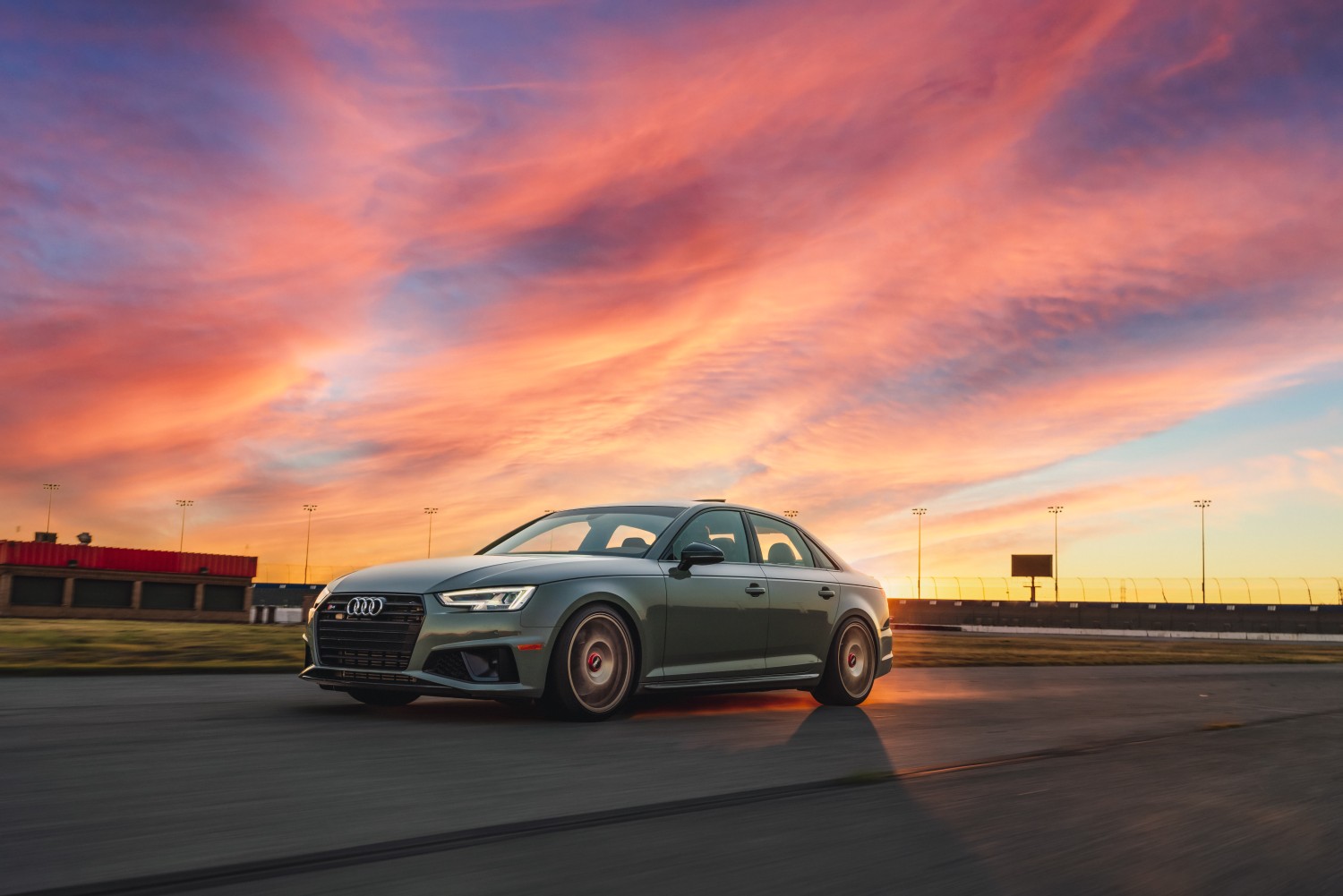
Thank you for stopping by! Wherever you’re headed next, we hope you enjoy the drive.
To learn more about our Ultra High Performance All-Season tire, the Azenis FK460 A/S, click on the button below.

